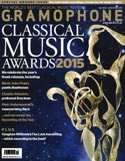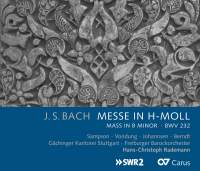Texte paru dans: / Appeared in: |
|
|
Outil de traduction (Très approximatif) |
|
|
Reviewer: David Vickers
Ulrich Leisinger’s new scholarly edition of the Mass in B minor is showcased by its publisher Carus with this deluxe recording accompanied by a hardback book. Plenty of interesting illustrations and the editor’s rigorously scholarly essay are joined by a probing DVD documenting Hans Christoph Rademann’s preparations from research to the rehearsal room, concert hall and the recording studio. The back cover claims that ‘For the first time a recording consistently follows the Dresden parts in the Kyrie and Gloria’.
Accordingly, small refinements found only in Bach’s manuscript parts dedicated in 1733 to the Elector of Saxony are observed, such as fully detailed and finished bassoon and flute parts in some movements, Lombardic rhythms and a single solo flute in ‘Domine Deus’ and a few marginally different solo bass voice passages in ‘Quoniam’ that were recomposed about 16 years later, when Bach prepared the Missa tota version. However, the quartet of soloists has one voice fewer than is evident in the Dresden parts: Rademann allocates ‘Laudamus te’ to his only soprano soloist, Carolyn Sampson (who sings it supremely well), but Bach wrote it in the soprano 2 part; likewise, the second soprano solo part in ‘Christe eleison’ is allocated to the alto Anke Vondung (whose firmly focused Agnus Dei might appeal to those who hanker after a more traditional and feminine alternative to countertenors). Neither do the soloists sing in the choruses, which is manifestly what Bach expected in all five of the
Dresden choir parts. Nevertheless, Carus enables the curious-minded to check such things for themselves because the DVD includes downloadable files of the original Dresden manuscript parts.
Taken on its own terms, the musical performance has much to recommend it. Rademann’s sincerely thoughtful and engaging direction confirms that the Gächiger Kantorei Stuttgart (founded by Helmut Rilling half a century ago) is in safe hands, and the involvement of the period instrument Freiburg Baroque Orchestra and a quartet of stylish soloists all indicates that things are quietly moving on towards a more up-to-date way of doing things. There is not the obvious theatrical crackle, contrapuntal leanness or polemic performance-practice radicalism of some important recordings of the last few decades. But the opening Kyrie has an almost tangible beauty and offers a sense of dignified penitence, whereas there is lively conversational rhetoric between all choral and instrumental participants in the splendid opening of the Gloria (the florid fugal details on ‘et in terra pax bonae voluntatis’ are expressed blissfully with marvellous cantabile shaping). The whispered ‘Qui tollis’ is held tautly in check and its finely balanced textures are convincingly supplicatory, and the controlled ‘Crucifixus’ has a clear emphasis on warm sonorities, textural density and emotional truthfulness. An ardent Benedictus feels somewhat laboured despite refined contributions from flautist Karl Kaiser and tenor Daniel Johannsen, and the tempo for the Agnus Dei is on the selfindulgent end of the reasonable spectrum, but otherwise Rademann’s flowing pacing conjures a gentle sense of forward momentum without ever appearing to rush unduly, and on a few occasions he springs surprises such as an astonishingly fast yet light-footed Sanctus.
An appendix includes recordings of the original 1724 version of the Sanctus and Bach’s familiar later versions of ‘Domine Deus’ and ‘Quoniam’; in the latter it is certainly no hardship to listen to Tobias Berndt’s suave singing in dialogue with Bart Aerbeydt’s supple horn obbligato twice over, but it is an odd experience when the appendix version does not segue into ‘Cum Sancto Spiritu’. |
|
|
|
|
|
Cliquez l'un ou l'autre
bouton pour découvrir bien d'autres critiques de CD |
|




